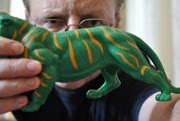Zone focusing is a useful technique for manual focus cameras, and for cameras with a slow autofocus. It involves setting the focus to a certain distance and then relying on depth of field (the zone) so that everything that you want to be in focus will then be sharp, or sharpish, in your photos.
It was the method relied on by old masters like Cartier-Bresson, who didn’t have autofocus cameras.*
It’s useful for wide-angle lenses, as they naturally have a big depth of field.
I use zone focusing for street photography on my Fujifilm X100 because the autofocus isn’t really fast enough for many situations where you need the camera to focus instantly. Using the manual focus mode (switch on the side set to MF) and setting the focus distance to about 11 ft, I know that at f/8 the focus will be good from 6 feet to almost infinity. In manual focus mode on the camera, you don’t have to wait for the camera to focus - it’s instant.
How to do it
With the X100, you set the focus distance to about 11 ft by referring to the focus distance scale that you can display in the viewfinder and LCD screen. (You might have to play around with customising the views so you can see this.) The focus distance is altered by turning the front ring on the lens. You will see that the focus distance scale appears to show depth of field but for some reason (on the X100 at least) it is hopelessly conservative – you will get much more in focus than it tells you. The focus distance indication is accurate though.
Depth of field calculator
Those are the settings (f/8 and 11 ft) that I usually use. You can play around with the values here (depth of field calculator) to see how they alter the depth of field:
http://www.dofmaster.com/dofjs.html
As it says on this site, you need to enter the actual focal length of the lens, not the 35mm equivalent (for the X100, the focal length of the lens is 23mm, so this is the value you use here). I believe that there is a phone app also on this site, although I have never used it.
As you will see when playing around with values - zone focusing is a useful technique for 28 mm or 35 mm lenses (in 35mm equivalent terms) as the depth of field is so big for these lenses but things become a lot more tricky/useless as you get to 50mm (in 35mm equivalent terms) and beyond. It's primarily a technique for wide-angle lenses.
So, once you have set your X100S/T/F camera to about 11 ft, f/8, you then set the ISO to a value that will consistently give you a fast enough shutter speed (1/500th second will cover most things).
Obviously, if you are a Bruce Gilden type, you will want the focus distance to be a bit closer than 11 ft so your zone of focus might stretch to as close as a couple of foot!
Unfortunately, on the X100 ( probably the X100S/T also) you cannot use the Auto ISO function (ISO Auto Control in the menu) to give you an appropriate ISO, as it only gives you the option of setting a minimum shutter speed of 1/125th second, when you will usually want a faster one than that. Big oversight by Fujifilm.
Pedantic bit
Zone focusing is using depth of field to get things in focus. Using the hyperfocal distance is a type of zone focusing where you set the focus distance so that the zone of focus stretches from a near point to infinity (and not beyond - if you can imagine beyond infinity - going beyond infinity would be a waste of your zone of focus).
Some people use the terms zone focusing and hyperfocal focusing as if they are the same thing – not correct – hyperfocal focusing is a type (subset) of zone focusing. For zone focusing, the zone of focus does not necessarily stretch as far as infinity. For example, a scene in focus from 6 ft to 100 ft would be more than ample for most of my urban street photography, and you are using zone focusing in this case but you are not using the hyperfocal distance/focusing, as by definition that means the focus would stretch to infinity.
Useful bit
On the X100, when you are in manual focus mode, you can use the AFL/AEL button to set the focus distance. So, I usually have the focus distance set at 11 ft, but if I suddenly want to focus on someone’s feet right in front of me, I point the camera at the spot and hit the button. Of course, you can quickly get the focus back to 11 ft by pointing it at an object about 11 ft away and fine-tuning by turning the lens focus ring.
A photo. If I'd relied on the X100's autofocus on this one, the lamp would have been out of the frame...
*It was trickier for Cartier-Bresson as he didn’t have the benefit of film as fast as the ISOs we can use today on our digital cameras – we can often use 2000 ISO in low light, if need be, so that we can use an appropriate shutter speed. That’s why so many of Cartier-Bressson’s photos are not sharp – he had to use a too-slow shutter speed – the sad loser.












